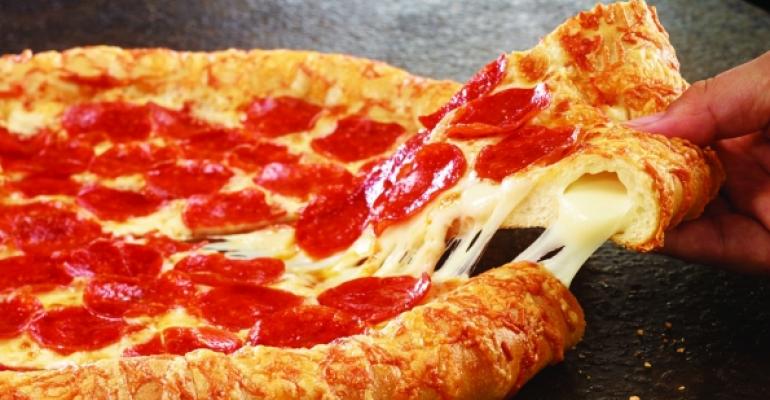Pizza Hut’s same-store sales rose 5 percent in the U.S. in the first quarter, thanks to technology efforts and the chain’s value promotions, and company executives said Thursday that the brand is back on track.
“It was the best result in Pizza Hut in the U.S. in years,” Greg Creed, CEO of the chain’s Louisville Ky.-based parent company, Yum! Brands Inc., said during the company’s first-quarter earnings call.
Pizza Hut’s same-store sales have been sluggish in recent years, even as competitors Papa John’s International Inc. and Domino’s Pizza Inc. have flourished. But the chain began to gain some momentum last year.
Executives on the call said that the chain’s $5 Flavor Menu resonated with customers and generated transaction growth. In addition, they said the company balanced the value effort with premium products “to protect unit-level economics.”
But technology is increasingly the name of the game in the pizza business, as both of those competitors established a market in which consumers order their food via phone.
Digital orders as a percentage increased 3 percent in the quarter, CFO David Russell said, and now represent 46 percent of all orders. But on the Super Bowl, 50 percent of orders came via digital channels.
“We’re making it easier to get a better pizza,” Creed said, noting that the company is focused on the entire process, including order payment and delivery tracking. He did note on the call that the chain needs to go from nine different point of sale systems to a single system. “We’re making good progress.”
But the company is also working on other areas to make the process easier. That includes ovens. The chain is replacing 1,300 ovens in the U.S. this year. Many of these new ovens will replace older ovens and will prepare pizzas faster while cutting energy use by 25 percent, Creed said.
Getting Pizza Hut’s U.S. sales on track is key for that chain, as the domestic business represents 60 percent of Pizza Hut sales. The company wants to roll out the same strategy used in the U.S. in other markets in the world.
Here are some other issues Yum executives talked about on the call Thursday:
• KFC in China had a good Chinese New Year. The brand’s same-store sales grew 12 percent in the first quarter. That’s important for Yum China because KFC represents 75 percent of the company’s profits there — Yum China’s operating profit rose 42 percent in the quarter.
The performance was surprising, executives said, and they credited much of that improvement with the success of the chain’s bucket meals in that country.
The performance “exceeded our expectations,” Russell said. Micky Pant, CEO of Yum in China, noted that next year would be the Year of the Chicken. “We’re already working on the promotions we’ll be running then,” he said.
• But Pizza Hut in China did not. On the opposite end was Pizza Hut casual dining in China, where same-store sales fell 12 percent. Executives on the call blamed the economy in China, which is slowing.
“The casual-dining sector was hit due to a decline in consumer confidence,” Pant said.
Still, executives expressed confidence in the brand’s ability to come back. And Pant said there’s time. “With KFC performing well, we have the ability to sort out Pizza Hut in the remaining quarters,” Pant said.
• No comment on a sale. Performance at Yum China is important because Yum plans to spin off the company’s operations into a separate company by the end of the year. Most of Yum’s 7,200 locations in China are company owned, and Yum China will be a Yum franchisee.
Reports in recent days, however, have suggested that Yum might sell a part, or even all, of its Chinese operations to an investor group.
“We are fully committed to maximizing the value of the China business for shareholders,” Creed said. “We will carefully consider all of our options to achieve that goal.”
• Taco Bell sales slow. Same-store sales at Yum’s Taco Bell unit slowed to 1 percent in the first quarter. Executives blamed the “timing of promotions” in the quarter for the results.
That came despite the chain’s big introduction of the Quesalupa in the first quarter. The product generated a “meaningful lift in transactions” and its product mix was 10 percent.
The chain did not get a benefit from its introduction of the $1 breakfast menu, meant to generate morning sales at the chain. Breakfast represents 6 percent of the chain’s sales, but Creed said that transactions improved in the quarter.
Contact Jonathan Maze at [email protected]
Follow him on Twitter at @jonathanmaze





